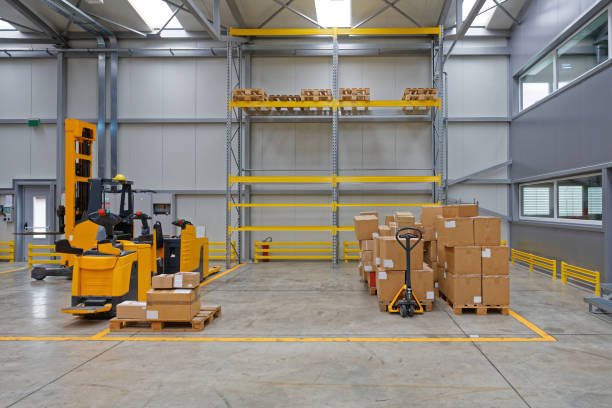Food processing units handle delicate, time-sensitive operations. From chilled storage to dry packaging zones, every step demands speed and care. In Singapore, where space is tight and food safety rules are strict, logistics inside food plants need sharp planning.
To move goods fast without waste or error, many companies now turn to electric machines. Among the tools gaining ground, the electric pallet truck stands out. It supports quick transport, helps cut human strain, and works quietly in tight indoor spots. Most food units now place this equipment at the heart of their material flow.
This article explores why these trucks shine in the food industry and how they compare with other lifting machines like the Reach Truck.
How an Electric Pallet Truck Works?
Electric pallet trucks move pallets across short or mid-range distances. Operators walk beside or ride on them, steering through aisles, cool rooms, and packing zones. Unlike manual trolleys, these trucks rely on battery power to lift, roll, and steer with ease.
In food units, time matters. Temperature zones shift quickly. Workers cannot afford delays, spills, or blocked lanes. This makes electric pallet trucks a vital part of the supply chain inside the plant.
The electric pallet truck for food industry Singapore operations uses today includes special hygiene coatings, sealed components, and quiet engines for safer, smoother movement.
Why Food Factories Choose Electric Pallet Trucks?
1. Boosts Speed in Daily Tasks
Time shapes success in food handling. Pallets of raw or cooked goods must shift without delay. Electric pallet trucks carry loads faster than hand tools and do not wear down the worker. This speed shortens task time, improves flow, and prevents storage pile-ups.
Speed helps reduce wait time between washing, cutting, cooking, and packing. Each unit moves smoothly to the next without lag.
2. Lowers Worker Fatigue
Manual pallet handling drains energy. It causes strain, pain, and sometimes injury. Electric models remove the heavy lifting. Workers steer and guide rather than push or drag.
This energy shift allows workers to stay sharp and safe. It also reduces the chance of errors or spoilage caused by drops or spills.
3. Fits Narrow Aisles and Cold Rooms
Food plants in Singapore often build tall, narrow zones to save floor space. Manual trolleys feel clumsy in these areas. Electric pallet trucks glide through small paths and tight corners.
They also perform well inside chillers or freezers. Their batteries keep the motor steady even when the air turns cold or damp.
Cleaner Operation Suits Food Zones
Unlike fuel-based machines, electric models leave no smoke, smell, or mess. Their clean energy system keeps floors and air safe for food work.
Food safety rules in Singapore demand clean workspaces. This includes storage zones, freezers, and even loading bays. The electric system makes sure the truck doesn’t leave oil leaks or dirt on the ground.
That’s one reason why the electric pallet truck for food industry Singapore factories use today must meet both movement and hygiene rules.
Better Control with Less Noise
Electric models run quieter than fuel or diesel machines. This helps in areas where focus matters, such as quality control rooms or ingredient mix zones.
Workers hear instructions. Alerts ring louder. Movement becomes easier to track.
These trucks also give smoother control over speed and brakes. That means fewer knocks or sudden stops, which protects both the goods and the floor space.
Reach Truck vs Electric Pallet Truck: What’s the Difference?
Many factories use both trucks, depending on the task and space. But they differ in size, height, and use. The Reach Truck climbs higher. The electric pallet truck rolls faster across shorter routes.
Comparison Table: Reach Truck vs Electric Pallet Truck
Before picking a machine, factory managers often compare key traits. Here’s a simple table to help:
| Feature | Reach Truck | Electric Pallet Truck |
| Use Height | Tall shelves | Floor-level pallets |
| Movement Range | Mid to long | Short to mid |
| Turning Space | Needs more room | Fits narrow lanes |
| Worker Operation | Requires seat | Walk or stand-on type |
| Noise Level | Moderate | Low |
| Clean Operation | Moderate | High |
| Best Use Area | Storage racks | Processing floor |
Both machines help move stock. But for fast shifts between stations, the pallet truck suits food work better.
Easy to Train, Easy to Use
Not all workers come with years of driving skill. That’s why simple control matters. Electric pallet trucks use buttons and handles that feel natural after a few tries.
This lowers the learning curve and helps new workers pick up speed. It also means fewer accidents or slowdowns during changeovers or new shifts.
Training workers on a Reach Truck takes longer. It also costs more. So, many managers use electric pallet trucks for entry-level jobs.
Keeps Food Handling Compliant and Safe
Singapore enforces strong food safety rules. Machines in food plants must meet hygiene, noise, and space standards.
Electric pallet trucks tick these boxes:
- No fuel leaks
- Quiet operation
- Non-slip wheels
- Easy-to-clean body
- Rounded edges to avoid harm
Their design prevents sharp turns, floor damage, or spills. In places where food touches machines, this clean build becomes vital.
Flexible for Every Food Industry Role
Electric pallet trucks handle many tasks:
- Move raw goods to prep areas
- Shift cooked food to cooling spots
- Carry packed boxes to storage
- Load outgoing stock onto trucks
This range of roles makes them a good choice for both large factories and small kitchens. As food plants change size or layout, these trucks adapt fast.
Many factories that also run Reach Truck models still rely on electric pallet trucks for most tasks close to the ground.
What to Check Before Choosing a Model?
Managers should ask key questions before choosing a truck:
- Does it fit narrow lanes?
- Can it stand cold or wet air?
- Is it easy to clean?
- How long does the battery last?
- Does it support the load size we handle?
Once these answers line up, the right model becomes clear.
Conclusion
Electric pallet trucks now support most steps in food plants—from raw handling to final loading. Their clean build, fast motion, and easy use make them a smart tool.
When food safety, speed, and worker health matter, electric machines help meet the mark. Their quiet strength fits the needs of factories in Singapore, where space, safety, and smooth flow guide daily work.
For any manager exploring tools for material flow, the electric pallet truck for food industry Singapore teams use today offers a proven path forward—one that blends safety, speed, and smart control.
FAQ’s
1. What is an electric pallet truck?
An electric pallet truck is a powered machine that helps workers lift, move, and stack heavy pallets with less effort compared to manual hand trucks.
2. Why do food processing units in Singapore choose electric pallet trucks?
Food processing units choose them because they speed up material handling, reduce worker fatigue, and maintain strict hygiene by minimising direct contact with products.
3. How do electric pallet trucks improve efficiency in food plants?
They cut down the time spent moving goods, handle heavier loads smoothly, and allow operators to cover longer distances quickly in large facilities.
4. Do electric pallet trucks help with workplace safety?
Yes, they reduce the risk of injuries like back strain or slips, since workers don’t need to push or pull heavy loads by hand.



